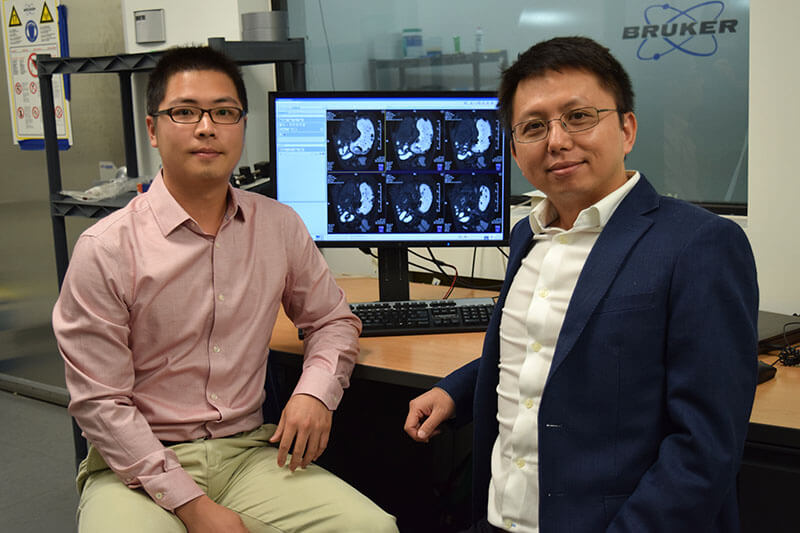Narzędzie MRI obserwuje, jak stymulacja elektryczna może leczyć zaburzenia trawienia
Więcej niż 60 milion ludzi w Stanach Zjednoczonych. cierpią na zaburzenia przewodu pokarmowego, które można wyleczyć za pomocą stymulacji elektrycznej, ale naukowcy nie w pełni rozumieją wpływ terapii na narząd krytyczny: żołądek. Naukowcy z Uniwersytetu Purdue wykorzystali rezonans magnetyczny, aby wykazać na bieżąco, w jaki sposób wysyłanie stymulacji elektrycznej do nerwu błędnego skutecznie koryguje powikłania żołądkowe. Technika ta toruje drogę do bardziej precyzyjnego leczenia, którego nie udało się osiągnąć za pomocą leków i zmian w diecie.
 Nowa technika rezonansu magnetycznego pomaga naukowcom zrozumieć, w jaki sposób żołądek reaguje na stymulację nerwu błędnego, które mogłyby zapewnić bardziej precyzyjne leczenie zaburzeń trawiennych. (Wideo Uniwersytetu Purdue/Kun-Han Lu) Pobierz obraz
Nowa technika rezonansu magnetycznego pomaga naukowcom zrozumieć, w jaki sposób żołądek reaguje na stymulację nerwu błędnego, które mogłyby zapewnić bardziej precyzyjne leczenie zaburzeń trawiennych. (Wideo Uniwersytetu Purdue/Kun-Han Lu) Pobierz obraz“Wyobraź sobie „konia Charleya” w każdym mięśniu twojego ciała, poprzez poproszenie pacjenta o poddanie się wielokrotnym skanom MRI przy różnych ustawieniach stymulacji elektrycznej, moglibyśmy znaleźć najlepsze ustawienie stymulacji w celu złagodzenia objawów danego pacjenta,” powiedział Kun-Han “Tomek” Lu, doktorat. student w elektrotechnika i informatyka.
Praca, która jest publikowana jako okładka czasopisma Neurogastroenterologia i motoryka w swoim październiku 2018 wydanie, pokrywa się z Purdue Gigantyczne skoki uroczystość, uznając globalny postęp uniwersytetu w dziedzinie zdrowia, długowieczność i jakość życia w ramach obchodów 150. rocznicy Purdue. To jeden z czterech tematów całorocznych obchodów Pomysły na festiwal, zaprojektowany, aby zaprezentować Purdue jako centrum intelektualne rozwiązujące rzeczywiste problemy.
Zaburzenia trawienia stanowią obciążenie medyczne miliardy dolarów rocznie.
Jednym z ważnych wskaźników zaburzeń trawiennych jest szybkość, z jaką żołądek opróżnia się z pokarmu, Gra składa się z sześciu okresów “opróżnianie żołądka,” do jelita cienkiego w celu wchłaniania składników odżywczych. Powolne opróżnianie żołądka w zaburzeniach gastroparezy, na przykład, oznacza, że mięśnie brzucha nie poruszają się prawidłowo.
Stymulacja nerwu błędnego pozwoliłaby lekarzom kontrolować szybkość opróżniania żołądka, skutecznie leczy gastroparezę.
“Niektóre protokoły stymulacji żołądka u ludzi zostały już zatwierdzone przez FDA, ale okazały się one jedynie częściowo skuteczne,” powiedział Terry'ego Powleya, Wybitny profesor Purdue Neuronauka i dyrektor SPARC (Stymulowanie aktywności obwodowej w celu łagodzenia schorzeń) projekt, inicjatywa Narodowego Instytutu Zdrowia mająca na celu zmapowanie obwodów nerwowych żołądka.
 Badacze z Purdue University, Kun-Han Lu (lewo) i Zhongming Liu (Prawidłowy) zapewniają ocenę czynności żołądka w czasie rzeczywistym, co pozwala na lepsze terapie. Pobierz obraz
Badacze z Purdue University, Kun-Han Lu (lewo) i Zhongming Liu (Prawidłowy) zapewniają ocenę czynności żołądka w czasie rzeczywistym, co pozwala na lepsze terapie. Pobierz obraz
W ramach projektu SPARC, Badacze z Purdue zaproponowali zastosowanie rezonansu magnetycznego u małych zwierząt, aby uzyskać lepszy obraz wpływu stymulacji nerwu błędnego na żołądek.
“Badania MRI są nieinwazyjne, dobrze pokazują kontrast tkanek i ułatwiają powtórzenie eksperymentu w celu weryfikacji,” powiedział Lu. Film na YouTube jest dostępny pod adresem https://youtu.be/ewsx0g2suSE.
Lu stymulował nerw błędny, aby kontrolować zwieracz odźwiernika u szczurów, zastawka kontrolująca opuszczanie żołądka i przedostawanie się pokarmu do jelita cienkiego. Następnie z biegiem czasu stworzył rekonstrukcje 3D obrazów MRI. Obrazy pokazały, że stymulacja rozluźniła zwieracz odźwiernika, przyspiesza opróżnianie żołądka, aby potencjalnie skorygować opóźnione opróżnianie w przypadku gastroparezy, lub innego rodzaju zaburzenia żołądkowo-jelitowe.
“Metoda ta dostarcza informacji fizjologicznych pozwalających zrozumieć wpływ dowolnego leczenia, dzięki czemu można je dostosować do konkretnego narządu lub konkretnego zaburzenia.,” powiedział Zhongming Liu, adiunkt ds Inżynieria biomedyczna oraz inżynieria elektryczna i komputerowa.
Naukowcy planują udoskonalić tę technologię, aby uzyskać jeszcze więcej informacji na temat fizjologii żołądka i przeprowadzić własne testy różnych metod leczenia zaburzeń żołądka.
Źródło: www.purdue.edu, autorstwa Kayli Wiles


Zostaw odpowiedź
Musisz Zaloguj sie lub Zarejestruj się dodać nowy komentarz .